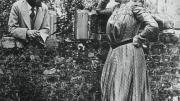“When bernard berenson presented to me a letter of introduction from an old college friend and was invited to visit my family at our house in the country at Fernhurst in England, his visit was like a chemical reaction.” In 1890, Mary (Smith) Costelloe was bored with life and her husband of five years, and avidly welcomed her guest’s enthusiasm for art and culture. Meeting the young scholar, a Lithuanian Jew recently graduated from Harvard, stirred giddy, girlish feelings that the future Mrs. Berenson recounted years later.
The daughter of Philadelphia Quakers, she had attended Smith College and then the Harvard Annex (later Radcliffe College) as one of its first eight students. She studied Berkeley, Hegel, and other philosophers, and recalled how once, after hearing the English art critic Edmund Gosse mention the “sacred word Botticelli” during a Harvard lecture, she looked at her brother, essayist Logan Pearsall Smith, “with eyes brimming with emotion and excitement,” and exclaimed: “Oh Logan! We are at the very centre of things!”
That fall of 1884, Mary Smith met Frank Costelloe, a visiting Irish Catholic barrister nine years her senior who seemed her ideal; she swiftly accepted his proposal of marriage and they wed in London the following September. “I had taken it for granted,” she wrote, “that philosophy and philanthropy, and English politics through which philanthropy could be most effective, were the only rational pursuits of human beings and I fully meant to dedicate myself to them, but when I got really into their toils they became dust and ashes in my mouth.” After several years focused on Frank’s activities, with one young child and another on the way, she confided to her journal that hers had become a one-sided marriage, leaving no time to complete her education.
When Berenson arrived that day for dinner, his hostess’s horizon expanded: “When this beautiful and mysterious youth appeared, for whom nothing in the world existed except a few lines of poetry which he held to be perfect and the pictures and music he held to be beautiful, I felt like a dry sponge that was put into water. Instinctively I recognized that those were the real values for me, however wicked and self indulgent they might be.” Though she learned later that “he thought my conversation very silly, but my pink satin dress very becoming,” she concluded, “[W]hen I was brought into contact with a brilliant, cultivated (and I must add handsome) contemporary who was not concerned with the Kingdom of Heaven, but passionately loved the earth and the beauties thereof, I felt that he possessed the key that would give me the entrance into a garden where I could live freely and be happy.”
There followed visits to picture galleries with Berenson, correspondence, and trips to Florence and Rome, chaperoned by her husband, until she decided in August 1891 to spend a year in Italy learning about art from Bernard. Upon her return to England, she asked for a divorce, which Frank refused. Separation meant leaving their two daughters in his care; though she had mixed feelings about child-rearing, Mary felt torn at having to choose “between being a person and being a mother.” Even so, and despite society’s disapproval, she returned to Bernard in Italy to continue her study of Renaissance painting. (Only after Frank died in 1899 were they able to marry.)
She began writing art-historical pamphlets and scholarly articles, sometimes under the pseudonym Mary Logan. In 1894, she co-wrote The Venetian Painters of the Renaissance with Bernard, although—at her mother’s insistence—she asked the publisher to omit her name as coauthor. Other publications followed, on individual artists as well as Italian schools of painting. These became quasi-textbooks for the emerging discipline of art history in the United States, and over the years, Mary secured her own reputation as a scholar and connoisseur of Italian Renaissance painting.
The Berensons’ lives and their study of art together are well known, including their extensive picture-dealing while working as intermediaries for art dealers, including the unscrupulous British dealer Joseph Duveen, and for wealthy collectors such as Isabella Stewart Gardner in Boston. Well known, too, were their ardent love affairs, which they dissected seemingly ad infinitum to each other until Mary tried (unsuccessfully) to throw herself out of a window in 1918 upon learning of yet another liaison on Bernard’s part.
As his wife and business partner, Mary was one of the most significant influences on Bernard Berenson’s career. Throughout their marriage of more than 50 years, even though she complained of his violent rage and his “slipshod sentences” as a writer, Mary never lost her admiration for his keen knowledge of art, connoisseurship, and culture. He continued to reawaken the sensation she reported about their first meeting: “At last, I felt, I really was at the centre of things, not sitting on a bench in Boston listening to a lecture, but partaking in imagination at least, of the real feast.”









